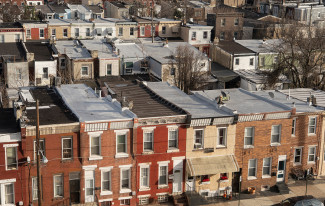With energy bills rising across most of the country, percentage-of-income payment plans and low-income energy assistance can deliver much-needed relief to struggling families.
Energy costs have risen faster than inflation since 2022 and in one region electric rates have jumped more than 25%, with forecasts of greater increases ahead. The causes include load growth from data centers, increasing electric transmission and distribution infrastructure and maintenance costs, extreme weather, and supply chain disruptions.
As utility bills rise faster than incomes, energy burdens—the percentage of income spent on energy—also increase. Low-income, Black, Hispanic, and rural households face higher burdens on average. Total household debt to utilities has increased by 31% in the last two years.
Equitable rate design can lower bills for struggling families
Low-income households can receive energy assistance through state and federal programs such as the Low Income Home Energy Assistance Program (LIHEAP). And the Weatherization Assistance Program can make bill-saving efficiency upgrades in homes. But many eligible households don’t receive such assistance, and even some who do still have high energy burdens. Many states run out of funding before they can reach all eligible households, as federal assistance budgets have not kept pace with inflation and growing program demand. One option to alleviate the burdens is to redesign rate strategies to more effectively lower utility bills for low- and moderate-income (LMI) families.
Percentage-of-income payment plans (PIPPs) cap utility bills for low-income households at a set percentage of household income. Tiered discount programs provide households with lower incomes a discount on their utility bills. Lifeline rates offer a lower rate for a set amount of essential energy use, with higher rates above that level. Flat discounts provide a fixed monthly utility bill credit. PIPPs and tiered discount programs are more likely to be responsive to seasonal and year-to-year shifts in household energy burdens, and some states have shifted away from flat discounts in recent years.
Affordability-focused rates are nothing new; Ohio implemented the first in 1983, and momentum has grown in recent years. These approaches can be paired with other reforms, such as rate structures that encourage heat pump adoption, which more fairly distribute winter heating costs.
High energy burdens in Rhode Island exemplify how rate reforms could bring significant relief
In the Northeast, energy costs are higher than the national average. Most states in the region have instituted some form of discounted utility rates for LMI households to help mitigate high costs. But Rhode Island, despite having the eighth-highest electricity rates in the country, has not instituted modernized rate design that alleviates energy burdens for the most vulnerable households. We looked at the numbers in Rhode Island—where the state legislature is expected to consider legislation next year to establish a PIPP—to see the difference the policy can make.
Electric rates in the state have jumped 28% since 2020 and are expected to continue growing faster in New England than the national average. According to our new analysis, a family of four in Rhode Island with an annual income of $48,000 pays $2,332 to $4,467 per year in energy bills, depending on energy consumption. At the higher end of the range, utility bills eat up nearly 10% of their pre-tax income.
Energy assistance programs available to vulnerable families in the state, such as LIHEAP, do not reach enough households and often do not provide sufficient assistance to significantly reduce energy burdens. We found that the family of four earning $48,000 would save $2,894 a year if the state adopted a PIPP. By contrast, the maximum LIHEAP grant is less than half that—$1,285 a year—with some families receiving as little as $75. Additionally, more than three-quarters of the 114,000 Rhode Island households eligible for LIHEAP in 2023 did not receive any assistance from the program, as federal funding levels have not kept pace with rising energy prices and energy burdens.
Rhode Island Energy’s existing flat low-income utility discount program leaves some families with energy burdens over 6%. While 6% has in the past been the standard used to identify energy-burdened households, many states are recognizing that as housing costs skyrocket as a percentage of consumer spending, especially for low-income families, targeting lower energy burden levels (such as 2% or 4%) is more representative of household budgeting needs and more effectively aligns low-income bills with state median energy spending. A PIPP tied to energy burdens would more effectively target financial support to the most vulnerable customers. PIPPs are also seasonally responsive. For example, when customers receive higher bills reflecting the heating required for the coldest winter months or peak summer cooling, a flat discount on those bills might still leave customers paying more than they can afford.
Reducing energy waste in low-income families’ homes can also help reduce their utility bills. Rhode Island had been a longstanding leader in energy efficiency, ranking third as recently as 2019 in ACEEE’s State Energy Efficiency Scorecard, but this year, it was down to #12, underscoring the need for redoubled efficiency efforts. But Rhode Island Energy, the state’s top utility, is proposing short-term cuts that undermine long-term savings. The utility’s efficiency program provides aggregate annual savings of $90 million for Rhode Islanders, but the proposal to slash efficiency funding would lower the average household utility bill by a mere $1.87 per month while increasing overall costs by leaving homes less efficient.
Pairing rate reform with energy efficiency delivers lasting affordability
Equitable rate redesign can be paired with expanded investments in energy efficiency to help lower bills. Discounting customer bills immediately reduces energy burdens and, when paired with efficiency investments, can also provide stable and long-term energy affordability through measures such as weatherization and equipment upgrades. Because low-income families often live in older, less energy-efficient homes, efficiency measures can yield even greater savings for these households. State legislators looking to address rising energy bills should consider these equitable rate reforms alongside expanded energy efficiency efforts.

